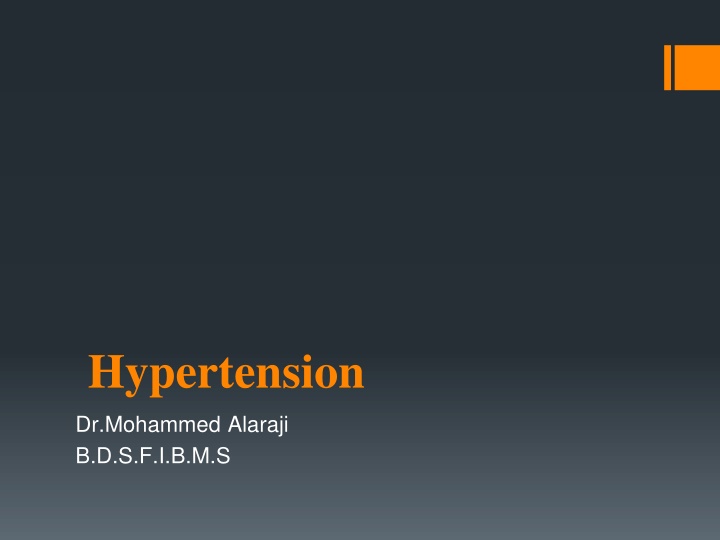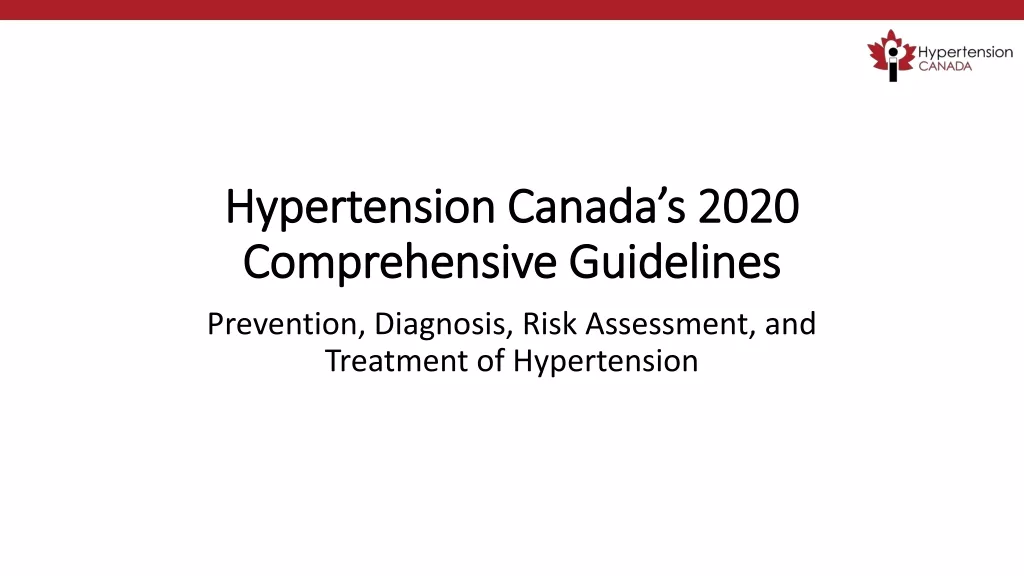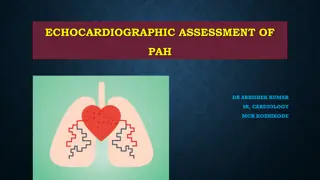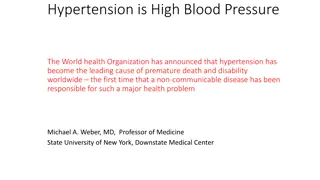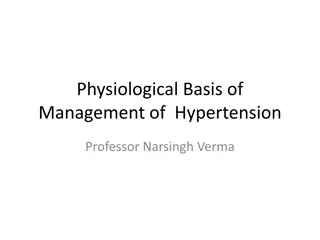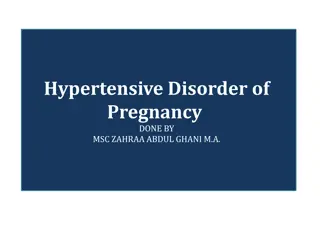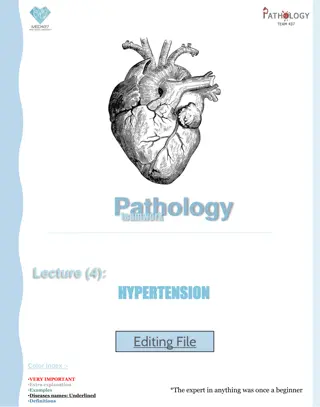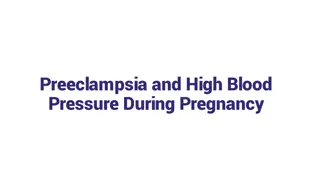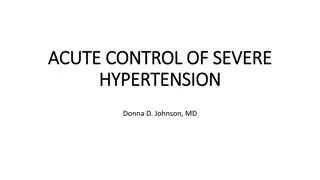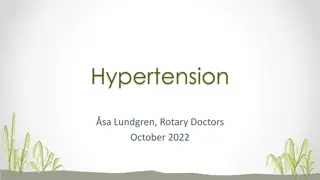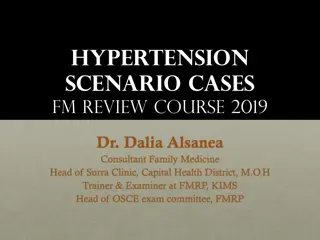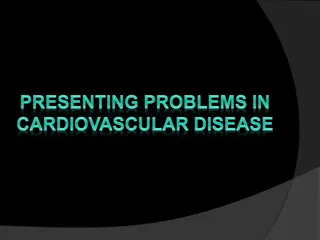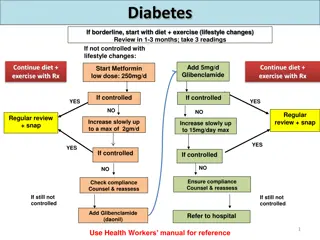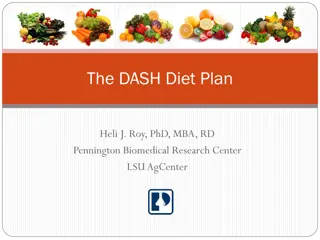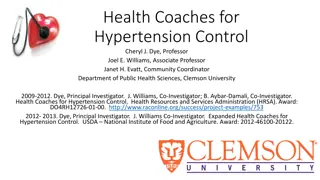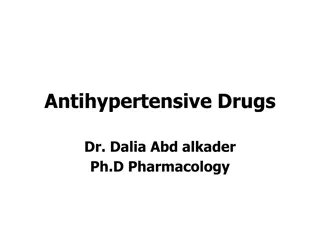Hypertension
Hypertension, or high blood pressure, is a common condition that can lead to serious health complications if left untreated. Learn about the causes, symptoms, and types of hypertension, including primary and secondary forms. Discover how elevated blood pressure can affect various organs in the body, such as the kidneys, heart, brain, and eyes. Recognize the importance of early detection and management to prevent potential complications associated with hypertension.
Download Presentation

Please find below an Image/Link to download the presentation.
The content on the website is provided AS IS for your information and personal use only. It may not be sold, licensed, or shared on other websites without obtaining consent from the author.If you encounter any issues during the download, it is possible that the publisher has removed the file from their server.
You are allowed to download the files provided on this website for personal or commercial use, subject to the condition that they are used lawfully. All files are the property of their respective owners.
The content on the website is provided AS IS for your information and personal use only. It may not be sold, licensed, or shared on other websites without obtaining consent from the author.
E N D
Presentation Transcript
Hypertension Dr.Mohammed Alaraji B.D.S.F.I.B.M.S
Hypertension is an abnormal elevation in arterial pressure that can be fatal if sustained and untreated. People with hypertension may not display symptoms for many years but eventually can experience symptomatic damage to several target organs, including kidneys, heart, brain, and eyes. In adults, a sustained systolic blood pressure of 140 mm Hg or greater and/or a sustained diastolic blood pressure of 90 mm Hg or greater is defined as hypertension.
systolic pressure is the force that the blood exerts on the artery walls as the heart contracts to pump the blood to the peripheral organs.
diastolic pressure is residual pressure exerted on the arteries as the heart relaxes. The difference between diastolic and systolicpressures is called pulse pressure
Etiology Primary/Essential/Idiopathic Hypertension is the most common type of hypertension. accounts for about 90% of all cases presenting with high blood pressure with no readily identifiable cause for their disease. This type of hypertension has a genetic link and is often associated with cardiovascular risk factors, smoking, obesity, lipid problems, and diabetes.
Secondary Hypertension is always due to an underlying cause such as intrinsic renal diseases, Pheochromocytoma, chronic corticosteroid therapy,, can lead to secondary hypertension. the symptoms are more severe, and Many patients with secondary hypertension may be cured after treatment of the underlying cause.
Signs and Symptoms of Hypertensive Disease EARLY Elevated blood pressure readings Narrowing and sclerosis of retinal arterioles Headache Dizziness Tinnitus ADVANCED Rupture and hemorrhage of retinal arterioles Papilledema Left ventricular hypertrophy Congestive heart failure Angina pectoris Renal failure Dementia
Antihypertensive agents Diuretics; these include Thiazide diuretics like like Furosemide. Angiotensin-converting enzymeinhibitors; like Captopril, Angiotensin receptor blockers (ARBs); like Candesartan and Losartan. Beta-adrenergic blockers; these are either Cardioselective like Atenolol, propranolol. Calcium-channel blockers like Amlodipine, Nifedipine, Verapamil. Alpha1-adrenergic blockers; like Doxazosin, Prazosin. Combined alpha and beta blockers; like Carvedilol. Vasodilators; like Hydralazine, and Minoxidil.
Dental Management Recommendations for Patients with Hypertension Stress/anxiety reduction. Short, morning appointments. Consider premedication with sedative/anxiolytic. Consider intraoperative use of nitrous oxide/oxygen. Obtain excellent local anesthesia; OK to use epinephrine in modest amounts.. Consider periodic intraoperative BP monitoring for patients with upper level stage 2 hypertension; terminate appointment if BP rises above 179/109. Slow position changes to prevent orthostatic hypotension.
Summry: Patients with blood pressure values ranging 140160/9095 mmHg may undergo dental surgery safely, whereas patients with blood pressure values ranging 160 190/95 110 mmHg will have to be given premedication half an hour to an hour before the surgical procedure, especially patients under stress. If the blood pressure values remain high even after premedication (e.g., over 180/110 mmHg) the dental session is postponed and the patient is referred to his/her physician for further treatment.
Coronary atherosclerotic heart disease is a major health problem in the United States and in other industrialized nations. Atherosclerosis is the thickening of the intimal layer of the arterial wall caused by the accumulation of lipid plaques. The atherosclerotic process results in a narrowed arterial lumen with diminished blood flow and oxygen supply. Atherosclerosis is the most common underlying cause of not only coronary heart disease (angina and myocardial infarction [MI]) but also cerebrovascular disease (stroke) and peripheral arterial disease (intermittent claudication). These risk factors include male gender, older age, a family history of cardiovascular disease, hyperlipidemia, hypertension, cigarette smoking, physical inactivity, obesity, and diabetes mellitus, mental stress, and depression.
1- Angina pectoris Angina pectoris is considered a clinical syndrome that is characterized by temporary ischemia in part of or all of the myocardium, resulting in diminished oxygen supply. An episode of angina pectoris presents as brief paroxysmal pain posterior to the sternum, may be precipitated by fatigue, extreme stress, or a rich meal, and subsides within 2 5 min after rest and the use of vasodilators. The patient may describe the episode as painful discomfort in the chest, with a burning sensation, pressure, or tightness. Pain may be present in the cardiac area, radiating to the left shoulder, neck, left arm (with a numb sensation as well as tingling), sometimes down the chin and teeth of the mandible (usually the left side), or it may even be felt at the epigastrium, causing confusion in diagnosis.
A- Stable angina is pain that is predictably reproducible and consistent over time. This pain typically is precipitated by physical effort such as walking or climbing stairs but may also occur with eating or stress. Pain is relieved by cessation of the precipitating activity, by rest, or by the use of nitroglycerin.
B- Unstable angina is defined as new onset of pain, pain that is increasing in frequency, more intense pain than before, pain that is precipitated by less effort than before, or pain that occurs at rest. This pain is not readily relieved by nitroglycerin. Patients with stable angina have a relatively good prognosis. Patients with unstable angina have a poorer prognosis and often develop MI within a short time.
diagnosis Resting ECG. Exercise ECG. ambulatory(Holter)ECG and exercise echocardiography. Coronary angiography.
Pharmacologic management Nitrates Beta blockers Calcium channel blockers Antiplatelet agents Percutaneous transluminal coronary angioplasty with stenting. Coronary artery bypass grafting.
2-Myocardial Infarction (MI) A myocardial infarction has a sudden onset with severe pain posterior to the sternum, which increases in severity rapidly and is characterized by a burning sensation, pressure, and extreme tightness. The pain is more severe compared to that of angina pectoris, lasting longer than 15 min and does not subside with rest or use of nitrates sublingually The pain may also be associated with nausea, vomiting, and dyspnea.
Diagnosis of MI Is by clinical features, ECG, change in the serum levels of cardiac enzymes which include; Troponin. And Lactic dehydrogenase (LDH).
NOTE:In general, recent MI and unstable angina are classified as clinical predictors of major risk for perioperative complications like serious arrhythmias and re-infarction. Stable (mild) angina and past history of MI are identified as clinical predictors of intermediate risk for perioperative complications.
Dental Management Considerations for Patients with Stable Angina or Past History of Myocardial Infarction Morning appointments Short appointments Comfortable chair position Nitroglycerin readily available Stress-reduction measures: Good communication Oral sedation (e.g., triazolam 0.125- to 0.25 mg on the night before and 1 hour before the appointment) Intraoperative N2O/O2 Excellent local anesthesia Limited use of vasoconstrictor (maximum 0.036 mg epinephrine, 0.20 mg levonordefrine) Antibiotic prophylaxis not recommended for patients with coronary artery stents. Antibiotic prophylaxis not recommended for history of coronary artery bypass graft (CABG). Adequate postoperative pain control
Dental Management Considerations for Patients with Unstable Angina or Recent Myocardial Infarction Avoid elective care If treatment is necessary, consult with physician and limit treatment to pain relief, treatment of acute infection, or control of bleeding Consider including the following: Prophylactic nitroglycerin Placement of intravenous line Sedation Oxygen Continuous electrocardiographic monitoring Pulse oximeter Frequent monitoring of blood pressure Cautious use of epinephrine in local anesthetic, combined with above measures.
NOTE: It is not always possible to treat patients in the dental office if they have suffered a myocardial infarction. It is considered prudent to avoid any routine dental surgery on patients with recent infarctions (within the last 6 months). In cases where treatment is deemed absolutely necessary (acute infection, pain, etc.), management should take place in a hospital. Six months following the myocardial infarction, patients may also be treated in the dental office, as long as the dentist follows the same recommendations as those that were described in the case of angina pectoris.
